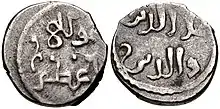Muhammad III of Alamut
ʿAlāʾ ad-Dīn Muḥammad III (علاءالدین محمد; 1211–1255), more commonly known simply as Ala ad-Din (علاءالدین), son of Jalāl al-Dīn Ḥassan III, was the 26th Nizāri Ismāʿilī Imām. He ruled from 1221 to 1255.[1] He was an esteemed scholar and the spiritual and worldly leader of the Nizari Ismailis, [2] He authored a constitution for the Nizari Ismaili which was practiced for very long time. The intellectual life of Persia flourished significantly during his reign of 34 years. [3] His vision of tolerance, inclusion and pluralism was a rare and shining example for that time. [4]His reign witnessed the beginnings of the Mongol devastations of Persia and the eastern Muslim world.[5] He was murdered under suspicious circumstances and was succeeded by his eldest son Rukn al-Din Khurshah in 1255.[5]


| Part of a series on Shīa Islam
Isma'ilism |
|---|
 |
|
|
Life
Alauddin Muhammad or Muhammad III was born in 609/1213. He succeeded his father at the age of 9 years. The administration of the state affairs had been governed by his gifted mother for about six years, which was the first instance when a woman administered at Alamut. The period of six years (618/1221 to 624/1227) was very peaceful in Alamut, during which time the Imam's mother seems to have deposed many incapable governors in Rudhbar and Kohistan. It seems that some governors and officers had misused their powers in that period. In 624/1227, Alauddin Muhammad took the power upon the death of his mother at the age of 15 or 16 years and dealt iron-handed with the persons misusing the powers. Most of them turned against him and went to live in Qazvin. In order to cover the story of their defalcations, they started to spread rumors against the Imam in bitter sarcasm. Some of them went on to propagate that the brain of Alauddin Muhammad had been affected a few months before 624/1227 when a physician operated him, causing waste of excess blood. The oppositions were however surmounted very soon. Under Muhammad III's reign, the Sunni conformity initiated by his father was gradually and quietly reversed[6] and his community increasingly regarded itself openly as Ismaili Shi'ite.[7][8]
Education and intellectual leadership:
The Nizāri Ismāʿilī Imām Alāʾ ad-Dīn Muḥammad was an esteemed scholar, who studied spiritual, philosophical and jurisprudence sciences, He was well known for his mystical statements which reflected his profound knowledge. He established a special school to train the Da'is the correct principals of inviting people to Nizari Isma'ili Islam.
He authored a seminal Constitution for the Nizari Ismailis entitled ‘Murids’. One of the Da’is, Shams Alden Ibn Ahmad Ibn Yaqoub Altaibi شمس الدين بن أحمد بن يعقوب الطيبي has documented that the treatise named "The Constitution and the Call to the Believers to attendance" "الدستور و دعوة المؤمنين إلى الحضور" was delivered to him by Da’i Nasir al Din al Tusi, who obtained it directly from Ala’ ad-Din Muhammad.[9] This treatise also mentioned that Ala’ ad-Din Muhammad dictated to his Hujja, Shams Alden Ibn Ahmad Ibn Yaqoub Altaibi , a Constitution called “The Constitution of Mawlana Ala'audeen " which displayed the high intellectual and scientific capacities of the Nizari Ismaili Imam. [10]
Alāʾ ad-Dīn Muḥammad offered special attention to the learned discussions and debates that took place in Alamut, He assigned one day per week to the philosophical and doctrinal debates between Da'is guiding them to polish their skills for dialectical debating offering pedagogical and argumentation techniques that made them very proficient in dialectical discussions and arguments.[2]
All-Dādīkhī, Qays b. Manṣūr (d.655/1257), the Syrian Nizārī author قيس بن منصور الداديخي was his Da'i to Syria, He had important philosophical treatises as Risālat al-asābīʿ, ed., ʿĀrif Tāmir, in his Khams rasāʾil Ismāʿīliyya, pp. 057-079 which discussed esoteric exegesis (taʾwīl) of certain Qurʾanic verses and Ismaili theology related to the number seven.[11] [12] All-Dādīkhī, Qays b. Manṣūr was a talented poet, who was expressed in the presence of Nizāri Ismāʿilī Imām Alāʾ ad-Dīn Muḥammad and his son Imam Rukn al-Din Khurshah verses to affirm the Fatimid origin of the Nizari Imam Alāʾ ad-Dīn Muḥammad, the title of that poem is "Degree of the Fatimid Imam is glorified" قدر الإمام الفاطمي معظم [12]
More recent studies in the last decade have revealed that intellectual life flourished during the long reign of Ala al-Din Muhammad and received a special impetus from the influx of outside scholars who now fled the first waves of the Mongol invasions and found refuge in the Nizari fortress communities of Persia. Foremost among such scholars who availed themselves of the Nizari libraries and patronage of learning, was Nasir al Din al Tusi (d 672/1274) who made major contributions to Nizari Ismaili thought of the late Alamut period during his three decades of stay among them. As elaborated in his spiritual autobiography, entitled ‘Sayr va suluk’, al Tusi in fact converted to Ismailism sometime during his prolonged association with the Nizari Ismailis.[3]
Tolerance and Pluralism
It is well documented that the Nizari Imam Ala al-Din Muhammad was very inclusive and pluralistic in his outlook. He granted patronage and shelter to various scholars from the surrounding countries destroyed by the Mongol invasion. [6] He granted access to libraries and offered all kinds of support. Nasir al Din al Tusi (d 672/1274) was one of his prominent Da'is who developed precious contribution to Ismaili theology. [6]
Ala al-Din Muhammad's alliance with the larger Muslim community had enlarged the boundaries of Nizari political aspirations. The grand vision of world domination returned for a time. Purely local squabbles were replaced by ambitious diplomatic activities to lands as far away as Europe and Mongolia while a Nizari religious mission was firmly established in India. Financial tribute for their safety was received from political leaders as distant as Germany, Aragon and Yemen.[13]
Besides his missions to create Christian-Muslim coalition in anticipation of the Mongols invasion, He was among the first to send peaceful message to the Great Khan Guyuk in Mongolia in full collaboration with the Sunni Abbasid Caliphate [14] The relationship with Abbasid Caliphate during his leadership was friendly and cordial. [15]
During his 34 years Imamate, he sent Da'is to Sind to establish Nizāri Ismāʿilī Islam in the Indian Subcontinent.[13]
Maymun-Diz fortress
Maymūn-Diz (Persian: میمون دز) was a major castle with a unique construction style built during the reign of the Nizāri Ismāʿilī Imām Alāʾ ad-Dīn Muḥammad on a high rock with a sharp cliff, it played a very important role for the Nizari Ismailis of the Alamut Period which is well captured historical records. [14]
Silver coins
Silver coins were used in 618 AH in the early period of Nizāri Ismāʿilī Imām Alāʾ ad-Dīn Muḥammad, It is important to note that such coins did not exist in Saljuq Iran at that time.[14]

Publication bias
We have new academic evidences that many citations about Alāʾ ad-Dīn Muḥammad were based on religious bias of Atâ-Malek Juvayni [16] who made allegations
that his rule was described as "cruel, imperious, sadistic, alcoholic, and unpredictable."[17] Atâ-Malek Juvayni was an important Sunni official of the Mongol empire which invaded and destroyed the Ismaili state,[18]
It is interesting to note the fantastical description of Marco Polo, copied by other European writers without verification, regarding Ala al-Din Muhammad III, the penultimate Lord of the Alamut is lacking historical authenticity, even though it has caught the imagination of many readers. The contemporary historian Juwayni, an avowed enemy of the Nizaris, who accompanied the Mongol leader Hulegu to Alamut in 1256 and carefully inspected the fortress before its destruction, does not report discovering any 'secret gardens of paradise' as claimed in Marco Polo's popular account.[19] Even though Juwayni mentions that he selected many 'choice books' from the famous Alamut library for his own purposes and unfortunately burnt other books that he did not like.[20]
See also
References
- Meriem Pages (2007). The Image of the Assassins in Medieval European Texts. ProQuest. p. 25. ISBN 9780549171683.
- Muṣṭafā, Ghālib (1953). History of Ismaili Da‘wah from oldest ages to current generation. Damascus: Alyaqza. p. 221.
- Daftary, Farhad (2012). Historical Dictionary of the Ismailis. Plymouth, UK: Scarecrow Press. p. 44. ISBN 978-0-8108-6164-0.
- Willey, Peter (2012). Eagle's Nest: Ismaili Castles in Iran and Syria. Bloomsbury I. B Tauris. pp. 135–141. ISBN 9781850434641.
- Farhad Daftary (15 May 1994). The Assassin Legends: Myths of the Isma'ilis (illustrated, reprint ed.). I.B.Tauris. p. 43. ISBN 9781850437055.
- Farhad Daftary (2012). Historical Dictionary of the Ismailis (illustrated ed.). Scarecrow Press. p. liv. ISBN 9780810861640.
- Jestice, Phyllis G., ed. (2004). Holy People of the World: A Cross-cultural Encyclopedia, Volume 1 (illustrated ed.). ABC-CLIO. p. 349. ISBN 9781576073551.
- Daryoush Mohammad Poor (18 September 2014). Authority Without Territory: The Aga Khan Development Network and the Ismaili Imamate. Palgrave Macmillan. p. 234. ISBN 9781137428806.
- Tamir, Arif (1978). Arbaat Rasaeil Ismaileah, 2ed edition. Beirut: Dar Maktabat Alhayat. p. 49.
- Mustafa, Ghalib (1964). A'alaam Al Ismailiah. Beirut: Alyaqaza Alarabya. p. 397.
- Daftary, Farhad (2004). Ismaili literature: A Bibliography Of Sources And Studies. Institute of Ismaili Studies. p. 111. ISBN 978-1-850-43439-9.
- Tamir, Arif (1956). Khams rasāʾil Ismāʿīliyya. Alinsaf. pp. 18–25.
- Daftary, Farhad (2020). The Ismaili Imams: A Biographical History. London UK: Bloomsbury I.B. Tauris. pp. 135–141. ISBN 9780755617982.
- Willey, Peter (2005). Eagle's Nest: Ismaili Castles in Iran and Syria. Bloomsbury Academic. pp. 75–85, 289. ISBN 978-1-85043-464-1.
- Daftary, Farhad (1998). A short history of the Ismailis – Traditions of a Muslim community. Edinburgh: Edinburgh University Press. ISBN 978-0-7486-7128-1. OCLC 820126490.
- Virani, Shafique N. (2003). "The Eagle Returns: Evidence of Continued Ismaili Activity at Alamut and in the South Caspian Region Following the Mongol Conquests". Journal of the American Oriental Society. 123 (2): 351. doi:10.2307/3217688. ISSN 0003-0279.
- James Wasserman (1 April 2001). The Templars and the Assassins: The Militia of Heaven. Inner Traditions / Bear & Co. pp. 124–5. ISBN 9781594778735.
- Virani, Shafique N. (16 April 2018). "Alamūt, Ismailism and Khwāja Qāsim Tushtarī's Recognizing God". Shii Studies Review. 2 (1–2): 193–227. doi:10.1163/24682470-12340021. ISSN 2468-2470.
- Daftary, Farhad (2007). The Ismailis, Their History and Doctrine, 2nd Edition,. New York, USA: Cambridge University Press. p. 18. ISBN 978 0 521 61636 2.
- Daftary, Farhad (2007). The Ismailis, Their History and Doctrines. New York, USA: Cambridge University Press, 2nd Edition. p. 305. ISBN 978 0 521 61636 2.
External links
‘Alā’ ad-Dīn Muḥammad III of the Ahl al-Bayt Clan of the Banu Quraish Born: 1211 C.E Died: 1255 C.E. | ||
| Regnal titles | ||
|---|---|---|
| Preceded by Jalālu-d-Dīn Ḥassan III |
7th Ruler of Nizārī Ismā'īlī state and Commander of Alamut Castle 1221–1255 |
Succeeded by Rukn-ud-Dīn Khurshāh |
| Shia Islam titles | ||
| Preceded by Jalālu-d-Dīn Ḥassan III |
Imām ‘Alā’ ad-Dīn Muḥammad III 26th Imām of Nizārī Ismā'īlīs 1221–1255 |
Succeeded by Rukn-ud-Dīn Khurshāh |